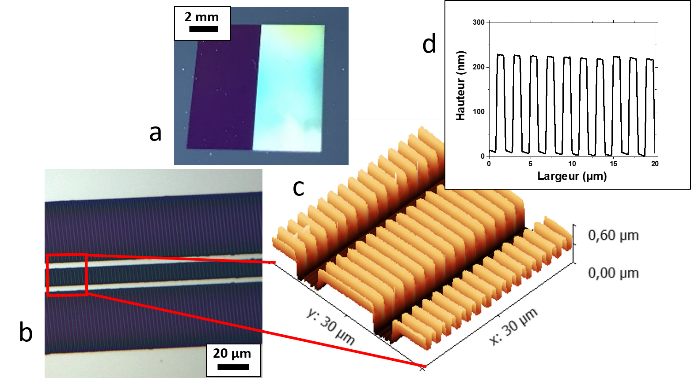New chemical optical sensors are studied for the real-time monitoring of dissolved oxygen (DO) in cell cultures. The sensors rely on an original micro-structured architecture, which is based on sol-gel protocols developed in the “Wet Chemistry and Surface Functionalization” axis of the FunSurf team. This architecture includes an epoxy/silicate cladding sub-layer that supports a channel waveguide. This latter is doped with a DO sensitive fluorophore (ruthenium complex) and it is endowed with diffraction gratings at its input and output in order to facilitate injection of the excitation signal in the guide and extraction of the emitted signal toward a photodetector. The waveguide and the diffraction gratings are obtained by photo-patterning a TiO2-based photosensitive resist. Ongoing research (elaboration, lithography, characterization, simulation) addresses the dimensionality, opto-geometric properties, fluorescence intensity, and DO sensitivity of the studied architectures. This work started recently (end of 2016) and has not yet been published


TiO2-based resist before (left) and after (right) photo-patterning of diffraction gratings (a); channel waveguides of various widths photo-patterned in a TiO2-based resist (b); AFM image (c) and profile (d) of TiO2-based diffraction gratings photo-patterned on channel waveguides.
Contact
Collaborators
- D. Riassetto, LMGP Grenoble (France)
- D. Bucci, IMEP-LAHC Grenoble (France)
- A. Morand, IMEP-LAHC Grenoble (France)
Non-permanent Staff
- Morgane Bonnel (PhD student)
FunSurf Research Topics
- Atmospheric Chemical Deposition of Functional Materials
- Wet Chemistry & Surface Functionalization
- Transparent Conducting Materials
- Nanostructures for Chemical and Biological Sensors
Projects
- Labex CEMAM « Nouvelle génération de capteur chimique optique opérant dans les milieux biologiques (BIOPTIC) » (2016-19)
- IRS project « Nouvelle génération de capteur chimique optique opérant dans les milieux biologiques (BIOPTIC) » (2018-19)



